生物安全水平(BSL)是在封闭的实验室设施中隔离危险生物制剂所需的一系列生物防护措施。围堵等级从最低的生物安全等级1(BSL-1)到最高的生物安全等级4(BSL-4)。在美国,疾病控制与预防中心(CDC)已指定了这些级别。[2]在欧盟,指令中定义了相同的生物安全等级。[3]在加拿大,这四个级别被称为“遏制级别”。[4]如“ P3实验室”一词,有时也将这些名称的设施称为P1至P4(用于病原体或保护级别)。
在最低的生物安全水平上,预防措施可能包括定期洗手和尽量少用防护装备。在较高的生物安全水平下,预防措施可能包括气流系统,多个密闭室,密封的容器,正压人员防护服,所有程序的既定规程,广泛的人员培训以及高水平的安全性,以控制对设施的访问。
![Essential features of a biosafety level 4 (BSL-4) laboratory[1].jpg Essential features of a biosafety level 4 (BSL-4) laboratory[1].jpg](data/attachment/forum/202002/05/133816qpw404m999ens9tp.jpg)
生物安全等级4(BSL-4)实验室的基本特征[1]
内容
1 历史
2 等级
2.1 生物安全等级1
2.2 生物安全等级2
2.3 生物安全等级3
2.4 生物安全等级4
2.4.1 BSL-4用于外星样品的设施
3 BSL-4设施清单
4 安全问题
5 参考
历史
第一个Class III(最大容纳)生物安全柜原型是1943年由当时的美军士兵Hubert Kaempf Jr.在美国工业健康与安全总监Arnold G. Wedum(1944-69)的指导下制造的。 马里兰州戴特里克营地的美国陆军生物战实验室。 Kaempf厌倦了在Detrick担任MP的职责,并能够与承包商H.K.一起调任至钣金部门。 弗格森公司[5]
1955年4月18日,十四名代表在马里兰州弗雷德里克(Frederick)的德特里克营集会。这次会议的目的是分享有关美国陆军三个主要生物战(BW)实验室的操作所共有的生物安全,化学,放射和工业安全问题的知识和经验。[6]由于可能会对生物战实验室进行的工作产生影响,因此这些会议仅限于最高级别的安全检查。从1957年开始,计划召开这些会议,包括非分类会议和分类会议,以实现更广泛的生物安全信息共享。直到1964年,这些会议才在与生物战计划无关的政府机构中举行。[7]
在接下来的十年中,生物安全会议的规模不断扩大,所有赞助或进行病原微生物研究的联邦机构的代表都参加了会议。到1966年,它开始包括来自大学,私人实验室,医院和工业园区的代表。在整个1970年代,参加会议的人数不断增加,到1983年,有关建立正式组织的讨论开始了。[7]美国生物安全协会(ABSA)于1984年正式成立,并于同年起草了宪法和章程。截至2008年,ABSA的专业协会中约有1,600名成员。[7]
1977年,澳大利亚科学院的吉姆·皮科克(Jim Peacock)向比尔·斯诺登(Bill Snowdon)询问当时的联邦科学与工业研究组织(CSIRO AAHL)是否可以接受美国国家卫生研究院(NIH)和英国等效的生物安全基础设施开发要求,以征求其建议。澳大利亚当局采用了其中之一。审查由CSIRO AAHL项目经理Bill Curnow和CSIRO工程师Arthur Jenkins进行。他们为每个安全级别起草了成果。 AAHL在概念上被归类为“基本上超出P4”。这些被澳大利亚科学院采用,并成为澳大利亚立法的基础。它于1985年开业,耗资1.85亿美元,以科里奥椭圆形平面为基础。[8]澳大利亚动物健康实验室是4 / P4类实验室。
等级
生物安全等级1
生物安全等级1(BSL-1)适合与特征明确的药物一起使用,这些药物不会对健康的人类造成疾病。通常,这些试剂对实验室人员和环境的潜在危害应最小。[9]在此级别,预防措施相对于其他级别是有限的。实验室人员在进出实验室时必须洗手。这些试剂的研究可以在标准的开放实验室工作台上进行,而无需使用特殊的遏制设备。但是,在实验室区域通常禁止饮食。[9]在处置之前,必须通过添加化学物质(例如漂白剂或异丙醇)或包装以在其他地方进行消毒来清除潜在的传染性材料。[9]仅在人员可能接触危险材料的情况下才需要使用个人防护设备。[9] BSL-1实验室必须有一个可以上锁的门,以限制进入实验室。但是,没有必要将BSL-1实验室与一般建筑物隔离。[10]
这种生物安全水平适用于处理多种微生物,包括大肠杆菌和葡萄球菌的非致病性菌株,枯草芽孢杆菌,酿酒酵母和其他怀疑不会导致人类疾病的生物。[11]由于维护BSL-1实验室相对容易和安全,这些类型的实验室通常用作高中和大学的教学空间。[10]
生物安全等级2
在此级别,将遵循生物安全级别1所使用的所有预防措施,并采取一些其他预防措施。 BSL-2与BSL-1的不同之处在于:
实验室人员接受了病原体处理方面的专门培训,并由科学家进行了高级培训。
工作进行时,进入实验室的机会受到限制。
对于被污染的锋利物品,要采取极端的预防措施。
在生物安全柜或其他物理遏制设备中,进行某些可能产生传染性气溶胶或飞溅物的程序。[9]
生物安全等级2适用于涉及对人员和环境具有中等潜在危害的媒介的工作。[10]其中包括各种微生物,这些微生物会对人类造成轻度疾病,或者在实验室环境中很难通过气溶胶感染。[12]例子包括甲型,乙型和丙型肝炎病毒,人类免疫缺陷病毒(HIV),大肠杆菌和葡萄球菌的致病株,沙门氏菌,恶性疟原虫和弓形虫。[12] [13]
生物安全等级3
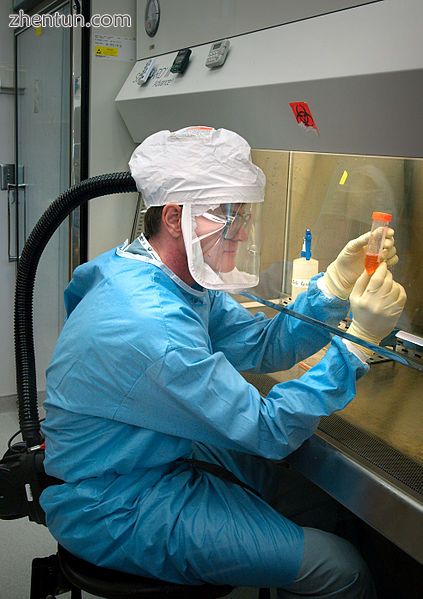
美国佐治亚州亚特兰大市疾病控制中心的研究人员正在3级生物安全水平下处理流感病毒,并在生物安全柜(BSC)内安装了呼吸器。
生物安全等级3适用于涉及可能通过吸入途径引起严重和潜在致命疾病的微生物的工作。[9]这类工作可以在临床,诊断,教学,研究或生产机构中进行。[10]这里,遵循了在BSL-1和BSL-2实验室中采取的预防措施以及其他措施,包括:
为所有实验室人员提供医疗监视,并为他们提供相关的免疫接种(如果有的话),以减少意外或未被注意的感****染的风险。[9]
所有涉及传染性材料的程序都必须在生物安全柜内进行。[9]
实验室人员必须穿坚实的前防护服(即绑在后面的服)。它不能在实验室外佩戴,每次使用后必须丢弃或净化。[9]
必须起草特定于实验室的生物安全手册,其中详细说明了实验室将如何按照所有安全要求进行操作。[9]
此外,容纳BSL-3实验室的设施必须具有某些功能,以确保适当的围堵。实验室的入口必须与交通畅通的建筑物区域分开。[9]此外,实验室必须位于两套自动关闭门的后面(以减少浮质逸出的风险)。[10]实验室的结构应易于清洁。不允许使用地毯,地板,墙壁和天花板上的任何接缝均应密封,以便于清洁和净化。[9]此外,必须将窗户密封,并安装通风系统,迫使空气从实验室的“干净”区域流到处理传染源的区域。[9]来自实验室的空气必须经过过滤,然后才能再循环。[9]
生物安全等级3通常用于涉及各种微生物的研究和诊断工作,这些微生物可以通过气溶胶传播和/或引起严重的疾病。这些包括土拉弗朗西斯菌,结核分枝杆菌,鹦鹉热衣原体,委内瑞拉马脑炎病毒,东部马脑炎病毒,SARS冠状病毒,MERS冠状病毒,伯氏柯立氏菌,裂谷热病毒,立克次氏体立克次氏菌,布鲁氏菌,基孔肯雅热,黄热病毒,几种西尼罗河病毒。[13]
生物安全等级4
另请参阅:生物安全级别4生物列表
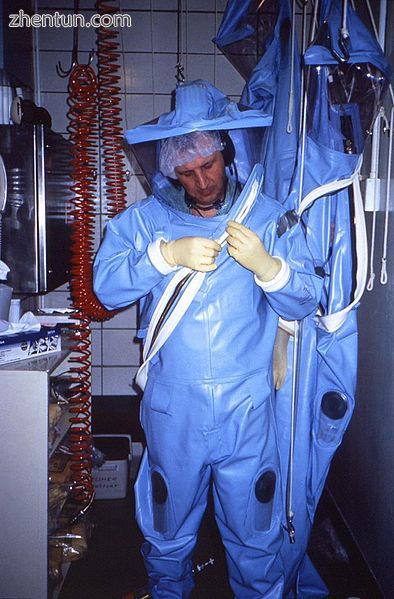
CDC的技术人员在进入CDC较早的BSL-4实验室之一之前就穿了旧式正压服。
生物安全级别4(BSL-4)是最高级别的生物安全预防措施,适用于可能在实验室内容易通过气溶胶传播并导致严重致死性疾病的药物,而目前尚无可用的疫苗或治疗方法。[9] BSL-4实验室通常设置为内阁实验室或防护服实验室。[9]在内阁实验室中,所有工作必须在III级生物安全内阁中进行。[9]离开橱柜的材料必须通过高压灭菌器或消毒剂罐进行消毒。[9]机柜本身需要具有无缝边缘,以便于清洁。另外,橱柜和其中的所有材料必须没有锋利的边缘,以减少损坏手套的风险。[9]在防护服实验室中,所有工作都必须由身穿正压服的人员在II级生物安全柜中完成。[9]为了退出BSL-4实验室,人员必须经过化学淋浴进行去污,然后经过一个移去正压防护服的房间,然后进行个人淋浴。[9]进入BSL-4实验室的人员仅限于经过培训和授权的人员,并且必须记录所有进入和离开实验室的人员。[9]
与BSL-3实验室一样,BSL-4实验室必须与流量不受限制的区域分开。此外,气流受到严格控制,以确保空气始终从实验室的“干净”区域流到正在与传染源进行工作的区域。[9] BSL-4实验室的入口还必须使用气闸,以最大程度地减少实验室中的气溶胶可以从实验室中清除的可能性。所有实验室废物,包括过滤后的空气,水和垃圾,在离开设施之前也必须进行净化处理。[9]
生物安全4级实验室用于可导致致命疾病的易传播病原体的诊断工作和研究。这些病毒包括许多已知会引起病毒性出血热的病毒,例如马尔堡病毒,埃博拉病毒,拉沙病毒和克里米亚-刚果出血热。 BSL-4处理的其他病原体包括亨德拉病毒,尼帕病毒和一些黄病毒。此外,通常在此级别上处理与危险病原体密切相关的特征不明确的病原体,直到获得足够的数据以确认在此级别上的继续工作或允许在较低级别上对其进行处理为止。[13]该水平还用于天花的病原体天花病毒的研究,尽管这项工作仅在美国亚特兰大的疾病控制和预防中心以及俄罗斯科尔佐沃的病毒和生物技术国家研究中心进行。[14]
![Regular inspection of positive-pressure suits to locate any leaks[15].jpg Regular inspection of positive-pressure suits to locate any leaks[15].jpg](data/attachment/forum/202002/05/133818f11zjxj1hl8mkbx4.jpg)
定期检查正压服,以发现泄漏点[15]
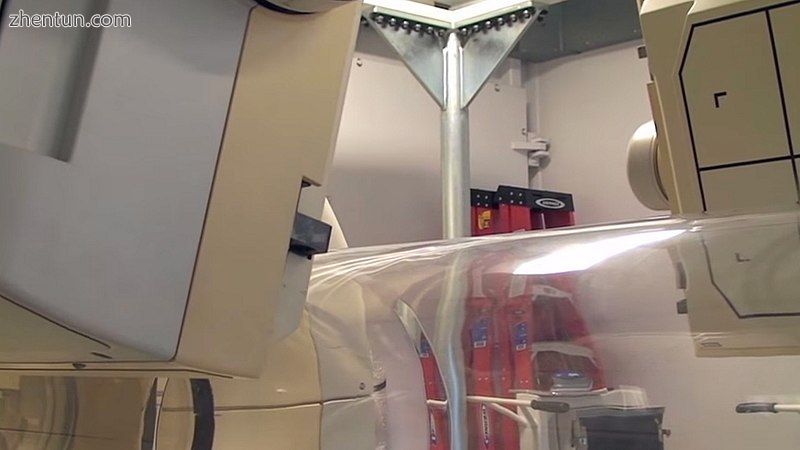
BSL-4成像设备上的SPECT机器将带有病原体的对象从机器中分离出来。[1]
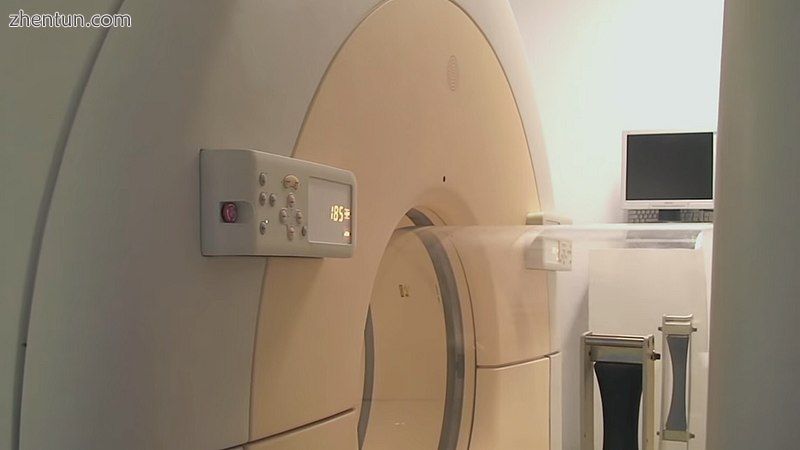
圆形容纳管将MRI机周围“热”区域(存在病原体)中的患者床从“冷”区域中分开。
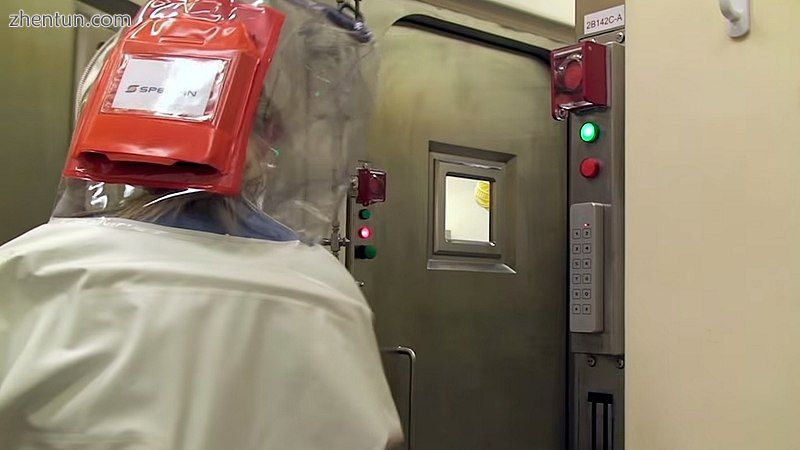
防风(APR)门将热区和冷区分开
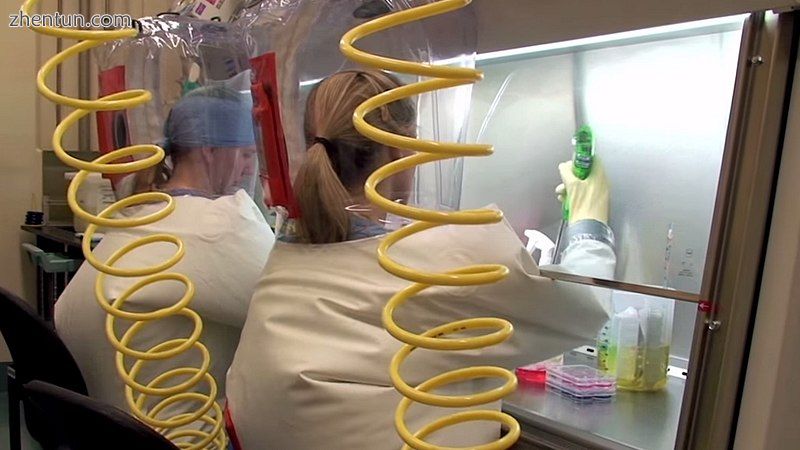
在BSL-4实验室内使用空气软管提供正向气压。
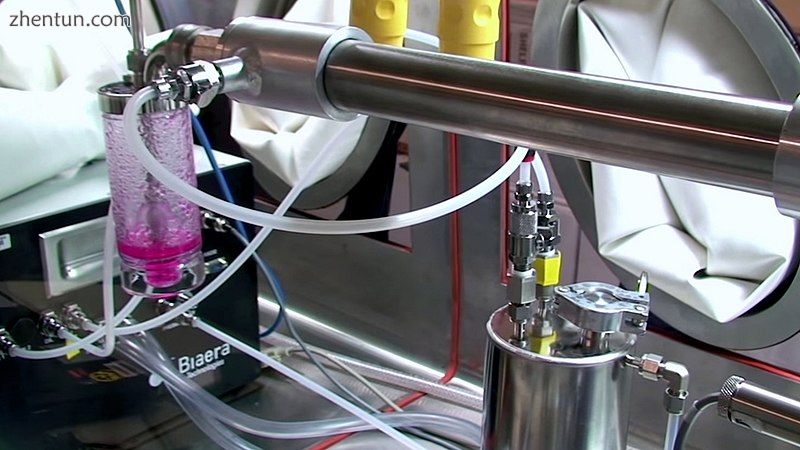
在带有气溶胶控制平台的III类生物安全柜内
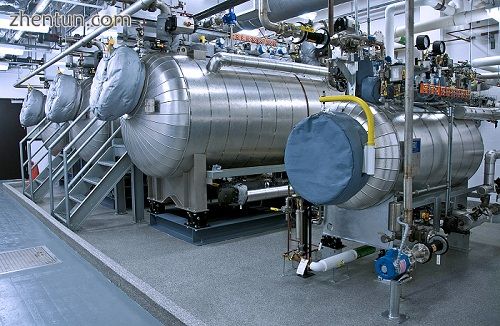
NIAID BSL-4实验室的污水净化系统
BSL-4用于外星样本的设施
主要文章:地球外样品策展
从V级机构获得的样品返回地球的样品返回任务必须在BSL-4级设施中进行策划。由于世界上现有的BSL-4设施并没有确保同时保护和保护地球和样品的复杂要求,[16]目前至少有两项建议来建立专门用于管理地球和样品的BSL-4设施。受限制的(可能有生物危害的)地球外物质。
第一个是提议在维也纳建造的欧洲样品处理设施(ESCF)[17] [18],它将管理非限制性样品以及从V类机构获得的受限材料的BSL-4瓶坯加工。火星,欧罗巴和土卫二。[17]另一项建议是由美国国家航空航天局(NASA)提出的,暂称为火星样本返回接收设施(MSRRF)。[19] 2009年至少提交了三种不同的设计。[16]如果有资金,这个美国工厂将从设计到完成需要7到10年,[20] [21],并且建议再增加两年时间,以使工作人员精通和习惯这些工厂。[20]美国宇航局也在评估2017年的一项提议,即建设一个移动式模块化BSL-4设施,以将样本返回舱固定在着陆点,以进行初步生物危害分析。[22]完成生物危害测试后,可以决定对样品进行灭菌或将全部或部分样品运输到世界任何地方的永久性检疫存储设施。[22]
这种设施的系统必须能够包含未知的生物危害,因为任何假定的外来微生物的大小都是未知的。理想情况下,它应过滤低至10纳米的颗粒,并且在任何情况下都不能释放50纳米或更大的颗粒。[23]
BSL-4设施清单
此列表不完整;你可以帮助扩展它。
根据2007年10月4日发布的美国政府问责局(GAO)的报告,在美国范围内总共发现了1,356个CDC / USDA注册的BSL-3设施。[24]这些实验室中约有36%位于学术界。 2007年,美国确定了15座BSL-4设施,其中包括9座联邦实验室。[24]
以下是全球现有BSL-4设施的列表。
安全问题
北卡罗莱纳州蚊子和病媒控制协会(NCMVCA)的一项研究强调了安全性问题。在美国,实验室可以由联邦,州,私人,非营利性或学术机构资助。最后一个占资金的72%。没有中央监测机构负责监测实验室,并且标准会根据资金,实验室的年龄而变化,并且取决于规模以及是否获得SA批准。[70]
在疾病控制与预防中心(CDC)和美国农业部(USDA)特选代理商计划中注册的高级实验室必须遵守国防部标准。[71]根据GSA调查的12个机构的答复,没有哪个联邦机构可以跟踪美国BSL-3和BSL-4实验室的总数。这意味着没有机构负责确定与这些实验室扩散相关的风险。[72]
参考文献:
"Integrated Research Facility". niaid.nih.gov. NIAID. Archived from the original on 28 November 2014. Retrieved 14 November 2014.
Richmond JY, McKinney RW (1999). Richmond JY, McKinney RW (eds.). Biosafety in Microbiological and Biomedical Laboratories (4th ed.). ISBN 0-7881-8513-6. Archived from the original on 2011-08-06.
Directive 2000/54/EC of the European Parliament and of the Council of 18 September 2000 on the protection of workers from risks related to exposure to biological agents at work (seventh individual directive within the meaning of Article 16(1) of Directive 89/391/EEC)
Canada, Public Health Agency of. "Chapter 2: The Laboratory Biosafety Guidelines: 3rd Edition 2004 – Biological safety - Canada.ca". www.canada.ca. Archived from the original on 23 February 2018. Retrieved 7 May 2018.
Covt, Norman M. (1997), “A History of Fort Detrick, Maryland” Archived 2008-09-22 at the Wayback Machine, 3rd edition. Kaempf retired from Fort Detrick in 1994, having completed more than 50 years service. He was chief of the mechanical branch, Directorate of Engineering and Housing.
Manuel S. Barbeito; Richard H. Kruse. "A History of the American Biological Safety Association". American Biological Safety Association. Archived from the original on 2008-06-20. Retrieved 2008-08-14.
"American Biological Safety Association Collection : NAL Collections : National Agricultural Library". United States Department of Agriculture: National Agricultural Library. 2009-02-11. Archived from the original on 2009-02-27. Retrieved 2009-02-11.
"CSIRO: Geelong - Australian Animal Health Laboratory".
"Section IV-Laboratory Biosafety Level Criteria". Biosafety in Microbiological and Biomedical Laboratories, 5th ed (PDF). U.S. Department of Health and Human Services. December 2009. pp. 30–59. Archived (PDF) from the original on 9 April 2016. Retrieved 2 April 2016.
Richmond JY. "The 1, 2, 3's of Biosafety Levels" (PDF). Archived (PDF) from the original on 19 March 2015. Retrieved 2 April 2016.
"Health & Safety Manual - Biological Safety". Columbia University Environmental Health and Safety. Archived from the original on 27 March 2016. Retrieved 2 April 2016.
"Section III-Principles of Biosafety". Biosafety in Microbiological and Biomedical Laboratories, 5th ed (PDF). U.S. Department of Health and Human Services. December 2009. pp. 22–28. Archived (PDF) from the original on 10 March 2016. Retrieved 9 April 2016.
For a list of infectious agents and the recommended biosafety level at which they should be studied, see "Section VIII-Agent Summary Statements". Biosafety in Microbiological and Biomedical Laboratories, 5th ed (PDF). U.S. Department of Health and Human Services. December 2009. pp. 123–289. Archived (PDF) from the original on 27 March 2016. Retrieved 9 April 2016.
"Section VIII-Agent Summary Statements". Biosafety in Microbiological and Biomedical Laboratories, 5th ed (PDF). U.S. Department of Health and Human Services. December 2009. p. 219. Archived (PDF) from the original on 13 May 2016. Retrieved 4 May 2016.
Seligson, Susan (7 March 2013). "Video Offers G跛行se of Biosafety Level 4 Lab Science webcast "threads the NEIDL"". BU Today. Archived from the original on 10 December 2014. Retrieved 5 December 2014.
How to Protect Mars Samples on Earth. Jeremy Hsu, Space. 3 December 2009.
EURO EURO-CARES Extraterrestrial Sample Curation Facility: Architecture as an enabler of science. (PDF) Aurore Hutzler, Emre Kilic, Allan Bennett, Ludovic Ferrière. 47th International Conference on Environmental Systems, 16-20 July 2017, Charleston, South Carolina. Document ICES-2017-323.
EURO-CARES. European Curation of Astromaterials Returned from Exploration of Space. Accessed: 25 September 2018.
Ronald 寰椎 (2002). "Mars Sample Return Receiving Facility" (PDF). NASA.
"7: "Sample-Receiving Facility and Program Oversight"". Assessment of Planetary Protection Requirements for Mars Sample Return Missions (Report). National Research Council. 2009. p. 59.
Mars Sample Return: Issues and Recommendations (Planetary Protection Office Summary) Task Group on Issues in Sample Return. National Academies Press, Washington, DC (1997)
Mobile/Modular BSL-4 Facilities for Meeting Restricted Earth Return Containment Requirements. M. J. Calaway, F. M. McCubbin, J. H. Allton, R. A. Zeigler, and L. F. Pace. (PDF) NASA. 2017.
European Science Foundation - Mars Sample Return backward contamination - Strategic advice and requirements Archived 2016-06-02 at the Wayback Machine
"High-Containment Biosafety Laboratories: Preliminary Observations on the Oversight of the Proliferation of BSL-3 and BSL-4 Laboratories in the United States" (PDF). United States Government Accountability Office. Oct 4, 2007. Archived (PDF) from the original on 12 February 2016. Retrieved 26 May 2016.
"Risk Analysis:Risk of Importing Foot-and-Mouth Disease in Susceptible Species and Products from a region of Patagonia, Argentina" (PDF). U.S. Department of Agriculture, National Import Export Services, Veterinary Services. January 2014. pp. 60–62. Archived (PDF) from the original on 21 October 2016. Retrieved 3 April 2016.
"Members: The Doherty Institute for Infection and Immunity". Global Virus Network. Archived from the original on 20 March 2016. Retrieved 3 April 2016.
Racaniello V (14 July 2014). "Visiting biosafety level-4 laboratories". Virology Blog. Archived from the original on 18 April 2016. Retrieved 3 April 2016.
"Laboratories: High Security/Quarantine". Victorian Infectious Diseases Reference Laboratory. Archived from the original on 19 April 2016. Retrieved 8 April 2016.
"Lanagro/MG é o primeiro do Brasil com nível de biosseguran**a máximo". MAPA - Ministério da Agricultura, Pecuária e Abastecimento. August 2014. Archived from the original on 23 February 2018. Retrieved 22 February 2018.
"National Microbiology Laboratory (NML) 概述". Public Health Agency of Canada. Archived from the original on 21 March 2016. Retrieved 8 April 2016.
"China Inaugurates the First Biocontainment Level 4 Laboratory in Wuhan". Wuhan Institute of Virology, Chinese Academy of Sciences. 3 February 2015. Archived from the original on 3 March 2016. Retrieved 9 April 2016.
"Biological Defence Department at Techonin". Ministry of Defense & Armed Forces of the Czech Republic. Archived from the original on 26 April 2016. Retrieved 9 April 2016.
"Jean Mérieux BSL-4 Laboratory". Fondation Mérieux. Archived from the original on 6 May 2016. Retrieved 11 April 2016.
"Inauguration du laboratoire biologique P4 de la DGA" (in French). Ministére de la Défense. Archived from the original on 8 May 2016. Retrieved 11 April 2016.
"Centre International de Recherches Medicales de Franceville" (in French). CIRMF. Archived from the original on 15 October 2014. Retrieved 30 September 2014.
"Das Hochsicherheitslabor im Robert Koch-Institut". Robert Koch Institut. Archived from the original on 19 May 2016. Retrieved 16 April 2016.
"Bernhard Nocht Institute for Tropical Medicine (BNI)". Heinrich Pette Institute. Archived from the original on 27 April 2016. Retrieved 16 April 2016.
"Friedrich Loeffler Institute, Germany". Caverion. Archived from the original on 22 April 2016. Retrieved 16 April 2016.
"Philipps-University Marburg". Philipps-University Marburg. Archived from the original on 11 June 2016. Retrieved 16 April 2016.
"Division of Virology". Országos Epidemiológiai K**zpont. Archived from the original on 24 September 2013. Retrieved 16 April 2016.
"Bio-containment Laboratory". National Institute of High Security Animal Diseases, India. Archived from the original on 19 March 2016. Retrieved 20 April 2016.
"Stone laid for stem cell research lab in Hyderabad". The Hindu. Archived from the original on 16 January 2016. Retrieved 25 April 2016.
"NIV Prune lab gets BSL-4". The Hindu. Archived from the original on 16 August 2017. Retrieved 24 April 2016.
"Storia dell'Istituto" (in Italian). IRCCS Lazzaro Spallanzani. Archived from the original on 7 March 2014. Retrieved 1 May 2016.
"Deadly disease lab opens amid local fears". Japan Times. 15 October 2015. Archived from the original on 28 April 2016. Retrieved 1 May 2016.
"Bio lab handling highly dangerous agents to open in suburban Tokyo". Japan Bullet. 3 August 2015. Archived from the original on 15 March 2018. Retrieved 14 March 2018.
"South Africa National Institute for Communicable Diseases". African National Public Health Institutes. Archived from the original on 18 March 2016. Retrieved 4 May 2016.
"P4-laboratoriet vid Folkh**lsomyndigheten" (in Swedish). Public Health Agency of Sweden. Archived from the original on 15 October 2014. Retrieved 8 October 2014.
Cherpillod, P. "Management of suspect viral hemorrhagic fever patient in Geneva". Schweizerische Union fur Labormedizin. Archived from the original on 16 August 2016. Retrieved 10 May 2016.
"Convention on the Prohibition of the Development, Production and Stockpiling of Bacteriological (Biological) and Toxin Weapons and on their Destruction" (PDF). Switzerland Federal Department of Defence, Civil Protection, and Sports. 2016. Archived (PDF) from the original on 3 June 2016. Retrieved 10 May 2016.
"Case of SARS reported in a laboratory research worker in Taiwan". Eurosurveillance. 18 December 2003. Archived from the original on 11 June 2016. Retrieved 18 May 2016.
Ewen Callaway (6 June 2013). "London biomedical hub sets its research agenda". Nature. Archived from the original on 7 June 2016. Retrieved 26 May 2016.
Davison N; Lentzos F (2012). "E8: High-Containment Laboratories-UK Case Study". Biosecurity Challenges of the Global Expansion of High-Containment Biological Laboratories. pp. 176–177. ISBN 978-0-309-22575-5. Archived from the original on 23 June 2016. Retrieved 26 May 2016.
Nisii, Carla; Castilletti, Concetta; Raoul, Hervé; Hewson, Roger; Brown, David; Gopal, Robin; Eickmann, Markus; Gunther, Stephan; Mirazimi, Ali; Koivula, Tuija; Feldmann, Heinz; Di Caro, Antonino; Capobianchi, Maria R.; Ippolito, Giuseppe (2013). "Biosafety Level-4 Laboratories in Europe: Opportunities for Public Health, Diagnostics, and Research". PLoS Pathogens. 9 (1): e1003105. doi:10.1371/journal.ppat.1003105. PMC 3547859. PMID 23349630.
"About DVBD - Division of Vector-Borne Diseases (DVBD) - NCEZID - CDC". www.cdc.gov. 17 April 2018. Archived from the original on 16 December 2017. Retrieved 7 May 2018.
"Operating a BSL-4 Laboratory in a University Setting". Tradeline. 16 December 2003. Archived from the original on 30 June 2016. Retrieved 28 May 2016.
"Leveraging the National Bio and Agro-defense Facility". Kansas State University. Archived from the original on 10 June 2016. Retrieved 28 May 2016.
"An Integrated Research Facility: Questions and Answers". National Institute of Allergy and Infectious Diseases. Archived from the original on 22 June 2016. Retrieved 28 May 2016.
"Integrated Research Facility 概述". National Institute of Allergy and Infectious Disease. Archived from the original on 5 July 2016. Retrieved 28 May 2016.
"National Biodefense Analysis and Countermeasures Center". Department of Homeland Security. Archived from the original on 20 May 2016. Retrieved 28 May 2016.
"USAMRIID: Biodefense Solutions to Protect our Nation". U.S. Army Medical Department. Archived from the original on 5 June 2016. Retrieved 28 May 2016.
"USAMRIID Biological Safety". U.S. Army Medical Department. Archived from the original on 18 May 2016. Retrieved 28 May 2016.
"NEIDL Goes Public: BU Biosafety Labs Offer Tours to Press, Politicians". Retrieved 30 December 2018.
"NEIDL BSL-4 Lab Gets Green Light". Retrieved 30 December 2018.
"National Emerging Infectious Diseases Laboratories: About - Mission and Safety". Boston University. Archived from the original on 4 June 2016. Retrieved 28 May 2016.
"Rocky Mountain Labs 概述". National Institute for Allergy and Infectious Disease. Archived from the original on 29 April 2016. Retrieved 28 May 2016.
"Galveston National Laboratory Fact Sheet". Archived from the original on 5 October 2014. Retrieved 30 September 2014.
"Center for Biodefense and Emerging Infectious Diseases: Safety and Biocontainment". UTMB Health. Archived from the original on 5 January 2016. Retrieved 28 May 2016.
"About Texas Biomed: Biosafety Level 4 Laboratory". Texas Biomedical Research Institute. Archived from the original on 3 April 2016. Retrieved 3 April 2016.
NCMVCA study Archived 2017-01-31 at the Wayback Machine- Retrieved 2017-01-19
DoD Safety Standards for Microbiological and Biomedical Laboratories Archived 2017-01-25 at the Wayback Machine- Retrieved 2017-01-19
GAO publication Archived 2017-01-20 at the Wayback Machine- Retrieved 2017-01-19 |